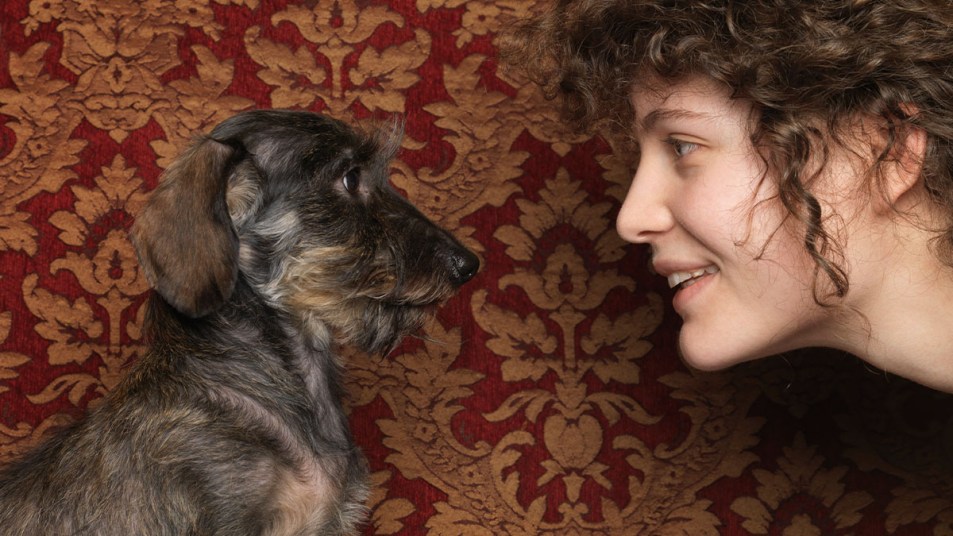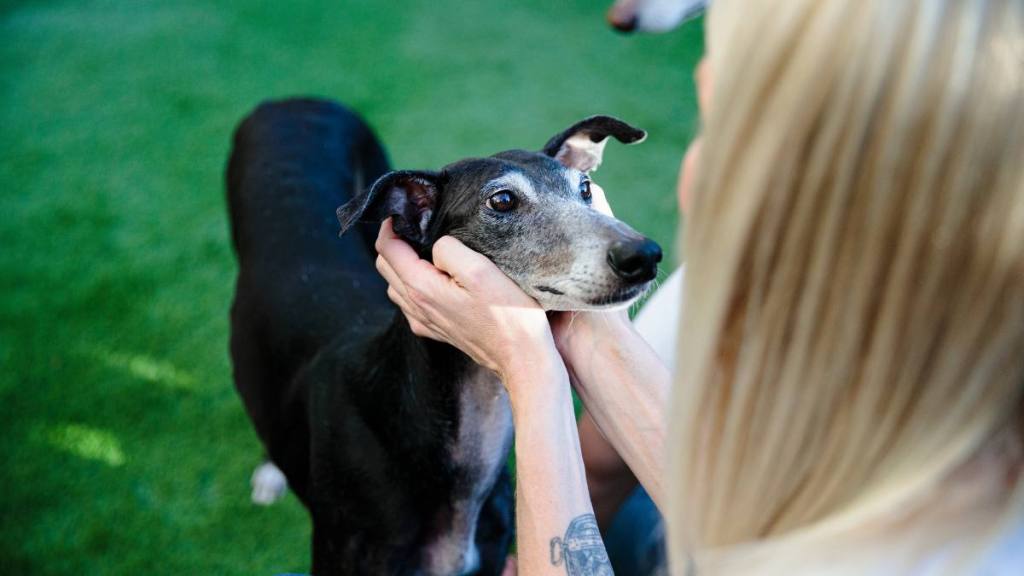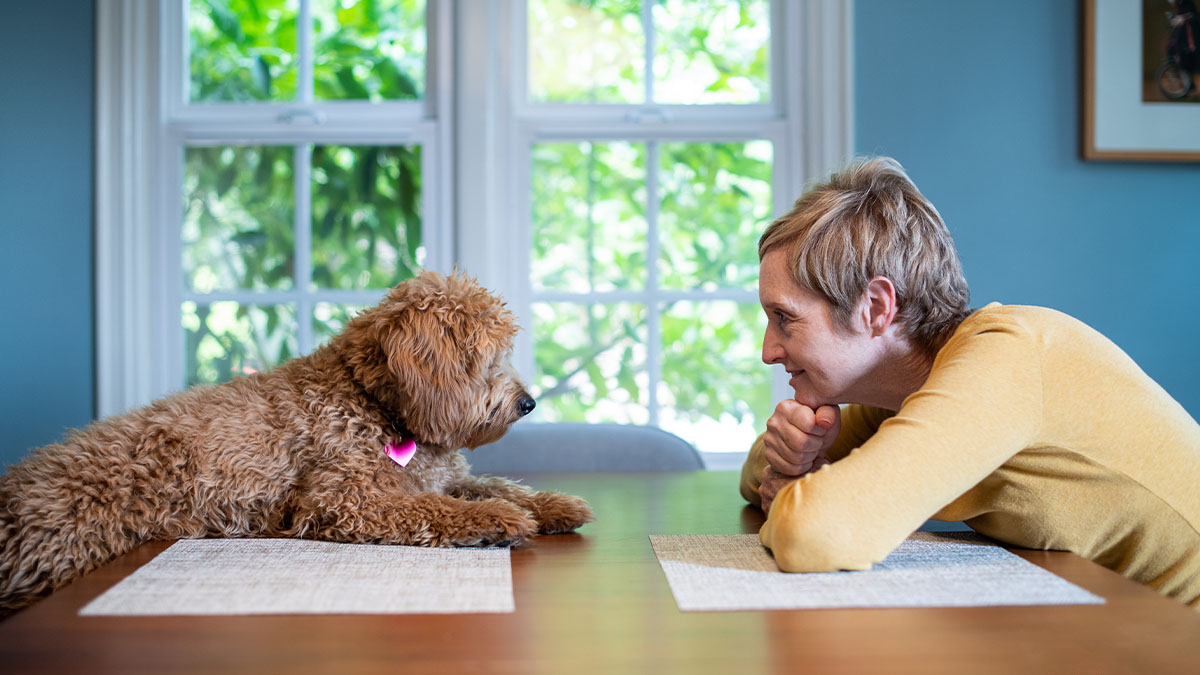Why Does My Dog Stare at Me? Veterinarian Explains What They’re Trying to Tell You
Plus, how to get him to stop.

Aw, those sweet puppy dog eyes — once again your pal staring so intently at you. Sometimes you want to whip out your camera and take hundreds of photos of that cute look. But other times Rover stares so much, it might even be unnerving and make you hear echoes of the chorus, “I always feel like somebody’s watching me.” Either way, you might be wondering, ‘Why does my dog stare at me?’ Is it a show of adoration? Or perhaps it’s because they’re trying to tell you something: Could they be out of water? Are they feeling unwell? Do they simply want to go outside? Read on to learn just what has them so focused on your glare.
Why does my dog stare at me?
“Sometimes staring is a show of love — just as humans gaze into the eyes of someone they love, dogs might look at their humans to show affection,” according to Sara Ochoa, DVM, veterinarian at The Animal Hospital of West Monroe and co-founder of Howto-pets.com. “Sometimes it’s a nonverbal form of communication.”
So how do you tell the difference and understand exactly what your favorite furball is trying to convey? You can start by reading his body language — just like humans, the way canines move their bodies can telegraph how they are feeling in the moment. Noting these cues can help you give you a better understanding of your dog’s intent. Because as it turns out, Dr. Ochoa says there are actually several possible reasons your dog might be giving you a good ol’ stare-down:
1. Your dog is showing you affection
Yes, just like humans, dogs can stare to show their adoration. When they stare into your eyes, they may actually be trying to create a deeper bond with you. In fact, a study from Japan found that owners who made loving eye contact with their pups experienced a boost of oxytocin, aka the love hormone, which can deepen the bond between the two. If it’s a look of love your sweet pup is giving you, you can tell by his relaxed body posture, wagging tail, a mouth that is soft and open — the corners might even be turned up in a ‘doggy smile’ — with a lolling tongue. All of these cues usually indicate a happy pup just trying to show his love.

2. Your dog wants your attention
Barking while staring could indicate a specific need or desire. Your dog may be staring at you simply because he wants your attention. Or he might be begging for a bit of playtime, want to go outside for a walk, desire some petting or maybe even hoping for a tasty treat from your plate. Dogs are social animals and your undivided attention is a reward for them.
3. Your dog is confused
Sometimes a stare can mean your little rascal is trying to comprehend what you want from him. If you’re training your dog or giving him a command, he may look at you closely to try to understand your expectations. Additionally, his ears might be perked up, which means he’s alert and focusing on something. Help your little buddy out by being clear and consistent with your commands.
4. Your dog is waiting for cues
Your dog might also be watching you intently to anticipate your next move. If he suspects a walk or playtime is on the horizon, he will keep his eyes peeled for any sign that it’s about to happen. If his ears are also perked and at attention, or he gives a head tilt, he might be trying to predict what comes next in his daily routine with you.
5. Your dog is feeling anxious
Sometimes staring can indicate anxiety. If your dog senses unsettling changes in the environment or if he’s feeling anxious, he might stare at you seeking reassurance or guidance. Or perhaps he’s even reacting to your feelings of anxiousness — a British study showed that dogs can recognize human emotion. Your pal might be constantly licking his lips, or tucking in his tail, all of which can signal anxiety or nervousness.
6. Your dog is displaying dominance
On a rarer and more behavioral side, a direct stare can signify a challenge or display of dominance. This is especially true if your pal is exhibiting other body language signals like a rigid posture, hair standing up on his neck or back, a stiff tail, ears pinned back or baring teeth, which are all displays of aggression — and it might be best to give your bud a little space to calm down.
7. Your dog may be sick
While staring is often harmless, it can also indicate a more serious problem in some cases. “If your dog is staring along with other unusual behaviors, it could be a sign of an underlying health issue,” says Dr. Ochoa. “Sometimes, excessive staring paired with whimpering, lethargy or glassy looking eyes can all be signs of pain or discomfort.” So in this case the answer to ‘why does my dog stare at me’ might indicate your sweetie is saying it’s time to pay a visit to the vet.
Should I stare back at my dog?

While a little staring is fine, you don’t want a constant stare-down. “Teaching your dog that staring for too long is not something he should do is certainly doable,” says Dr. Ochoa. “Some easy options are simply ignoring the behavior or teaching a command to make them stop.” To do this, simply say a phrase like, ‘look away’ and offer praise and a treat when they do. “Using positive reinforcement techniques help to encourage obedience,” says Dr. Ochoa.
Another way to end constant staring is to provide more stimulation to your furry friend. There are a couple ways to do this. “You can regularly engage your dog in more physical activities like walks and play,” advises Dr. Ochoa. “Mental stimulation, such as puzzle toys or regular training sessions, can also reduce the desire to stare because they’ll be busier.” Or taking them to a dog park where they can interact with other pups and their owners can help as well. “Regular interaction with other dogs and humans can help your dog become more independent,” explains Dr. Ochoa.
“In turn, this confidence in your canine can reduce clingy behavior, including constant staring.” Lastly, creating a predictable schedule for playtime and even feeding and walks helps reduce anxiety and the need for your dog to seek reassurance by staring.
What if a dog I don’t know is staring at me?
When it comes to dogs you don’t know, never return the stare, cautions Dr. Ochoa. Doing so might be a misinterpretation of your intentions, since to an unfamiliar dog, direct eye contact doesn’t necessarily mean the same as it does with your own buddy. “To a dog you just met this action can often be perceived as a challenge or threat,” says Dr. Ochoa.
“Dogs communicate very differently with each other than humans do — and in dog language, sustained eye contact is often a sign of dominance.” By making direct eye contact with a dog you don’t know, you may unwittingly imply that you’re challenging their social status. If the pup feels challenged by your stare, it could be misinterpreted as confrontational, which could escalate to aggressive behavior.
So the best approach is to look away. “By breaking the stare, you’re showing them courtesy and giving them the chance to approach you on their own terms, if they want to interact at all,” says Dr. Ochoa. “This can be the foundation of a trustful relationship.” Looking away from a dog allows for a more relaxed encounter. “By showing that you’re not a threat, a dog is more likely to warm up to you gradually,” says Dr. Ochoa. Especially if you’re encountering a stray or a dog that seems anxious or scared, prioritizing safety is key, and it’s best to avoid direct eye contact to avoid a potential misunderstanding
For more stories on dogs, click through the links below!
Surprising Causes of Your Dog’s Bad Breath + Vet-Approved Ways to Get Rid of It Fast
Dog Poop on the Carpet? These Easy Pro Tricks Will Get It Deep-Down Clean Fast
“I’m a Veterinarian and This Is a Red Flag That Your Dog’s Ears Need Cleaning!”
















